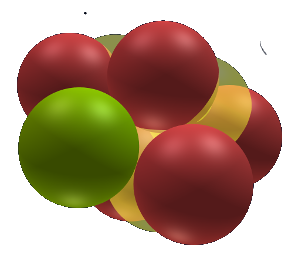| +1 |
Lithium
Atomic structure
N0:
state: lithium
protons:
P1:
P3: {color: neutron}
P4:
P5:
P9:
P10:
P11:
electrons:
E01: {protons: [P4, P5]}
E02: {protons: [P9, P1]}
E03: {protons: [P11, P10]}

|
Sodium
Atomic structure
N0:
state: final
protons:
P0:
P1:
P2:
P3:
P4:
P5:
P6:
P7:
P8:
P9:
P10:
P11:
P12:
P13:
P14:
P15:
neutrons: [U00]
electrons:
E01: {protons: [P2, P8]}
E02: {protons: [P5, P10]}
E03: {protons: [P0, P4]}
E04: {protons: [P1, P11]}
E05: {protons: [P7, P9]}
E06: {protons: [P6, P3]}
E07: {protons: [P13, P12]}
E08: {protons: [P14, P15]}
nuclets:
N01:
state: lithium
attachAngle: 3
protons:
P1:
P3:
P4:
P5:
P9:
P11:
electrons:
E01: {protons: [P3, P11]}
E02: {protons: [P1, P4]}
E03: {protons: [P9, P5]}
|
| +2 |
Beryllium
Atomic structure
N0:
state: beryllium
protons:
P1:
P3: {color: neutron}
P4:
P5:
P6:
P7:
P9:
P10:
P11:
electrons:
E01: {protons: [P4, P5]}
E02: {protons: [P10, P11]}
E03: {protons: [P6, P7]}
E04: {protons: [P9, P1]}
|
Magnesium
Atomic structure
N0:
state: final
protons:
P0:
P1:
P2:
P3:
P4:
P5:
P6:
P7:
P8:
P9:
P10:
P11:
electrons:
E01: {protons: [P8, P2]}
E02: {protons: [P5, P10]}
E03: {protons: [P3, P6]}
E04: {protons: [P11, P1]}
E05: {protons: [P4, P0]}
E06: {protons: [P7, P9]}
nuclets:
N00:
state: lithium
attachAngle: 3
protons:
P1:
P3:
P4:
P5:
P9:
P11:
electrons:
E01: {protons: [P3, P11]}
E02: {protons: [P4, P1]}
E03: {protons: [P5, P9]}
N01:
state: lithium
attachAngle: 3
protons:
P1:
P3:
P4:
P5:
P9:
P11:
electrons:
E01: {protons: [P4, P1]}
E02: {protons: [P3, P11]}
E03: {protons: [P9, P5]}
|
| +3 |
Boron
Atomic structure
N0:
state: boron11
protons:
P0: {color: neutron}
P1:
P2:
P3:
P4:
P5:
P6:
P7:
P9:
P10:
P11:
electrons:
E01: {protons: [P4, P5]}
E02: {protons: [P6, P7]}
E03: {protons: [P11, P10]}
E04: {protons: [P1, P9]}
E05: {protons: [P3, P2]}
|
Aluminum

|
| +4/-4 |
Carbon
Atomic structure
N0:
state: carbon
protons:
P0:
P1:
P2:
P3:
P4:
P5:
P6:
P7:
P8:
P9:
P10:
P11:
electrons:
E01: {protons: [P9, P8]}
E02: {protons: [P1, P0]}
E03: {protons: [P5, P4]}
E04: {protons: [P2, P3]}
E05: {protons: [P7, P6]}
E06: {protons: [P11, P10]}
|
Silicon
Atomic structure
N0:
state: final
protons:
P0:
P1:
P2:
P3:
P4:
P5:
P6:
P7:
P8:
P9:
P10:
P11:
P12:
P13:
P14:
P15:
neutrons: [U00]
electrons:
E01: {protons: [P9, P0]}
E02: {protons: [P7, P11]}
E03: {protons: [P1, P4]}
E04: {protons: [P10, P3]}
E05: {protons: [P6, P2]}
E06: {protons: [P8, P5]}
E07: {protons: [P15, P14]}
E08: {protons: [P13, P12]}
nuclets:
N01:
state: carbon
attachAngle: 3
protons:
P0:
P1:
P2:
P3:
P4:
P5:
P6:
P7:
P8:
P9: {color: proton}
P11:
electrons:
E01: {protons: [P3, P11]}
E02: {protons: [P1, P4]}
E03: {protons: [P6, P2]}
E04: {protons: [P7, P0]}
E05: {protons: [P8, P5]}
|
| -3 |
Nitrogen
Atomic structure
N0:
state: initial
protons:
P0:
P1:
P2:
P3:
P4:
P5:
P6:
P7:
P8:
P9:
P10:
P11:
P12:
P13:
electrons:
E01: {protons: [P9, P0]}
E02: {protons: [P8, P5]}
E03: {protons: [P6, P2]}
E04: {protons: [P3, P10]}
E05: {protons: [P7, P11]}
E06: {protons: [P4, P1]}
E07: {protons: [P13, P12]}
outerIcosaFaces: [F04,F06,F09,F11,F18,F19]
|
Phosphorous
Atomic structure
N0:
state: final
protons:
P0:
P1:
P2:
P3:
P4:
P5:
P6:
P7:
P8:
P9:
P10:
P11:
electrons:
E01: {protons: [P8, P2]}
E02: {protons: [P5, P10]}
E03: {protons: [P3, P6]}
E04: {protons: [P4, P0]}
E05: {protons: [P1, P11]}
E06: {protons: [P7, P9]}
nuclets:
N00:
state: beryllium
attachAngle: 5
protons:
P1:
P3:
P4:
P5:
P6:
P7:
P9:
P11:
electrons:
E01: {protons: [P3, P5]}
E02: {protons: [P4, P1]}
E03: {protons: [P9, P11]}
E04: {protons: [P6, P7]}
N01:
state: carbon
attachAngle: 3
protons:
P0:
P1:
P2:
P3:
P4:
P5:
P6:
P7:
P8:
P9: {color: proton}
P11:
electrons:
E01: {protons: [P3, P11]}
E02: {protons: [P1, P4]}
E03: {protons: [P0, P7]}
E04: {protons: [P5, P8]}
E05: {protons: [P2, P6]}
|
| -2 |
Oxygen
Atomic structure
N0:
state: initial
protons:
P0:
P1:
P2:
P3:
P4:
P5:
P6:
P7:
P8:
P9:
P10:
P11:
P12:
P13:
P14:
P15:
electrons:
E01: {protons: [P12, P13]}
E02: {protons: [P14, P15]}
E03: {protons: [P9, P0]}
E04: {protons: [P8, P5]}
E05: {protons: [P2, P6]}
E06: {protons: [P3, P10]}
E07: {protons: [P4, P1]}
E08: {protons: [P11, P7]}
|
Sulfur

|
| -1 |
Fluorine
Atomic structure
N0:
state: initial
protons:
P0:
P1:
P2:
P3:
P4:
P5:
P6:
P7:
P8:
P9:
P10:
P11:
P12:
P13:
P14:
P15:
P18:
P19:
neutrons: [U00]
electrons:
E01: {protons: [P18, P19]}
E02: {protons: [P9, P0]}
E03: {protons: [P8, P5]}
E04: {protons: [P4, P1]}
E05: {protons: [P6, P2]}
E06: {protons: [P3, P10]}
E07: {protons: [P11, P7]}
E08: {protons: [P15, P14]}
E09: {protons: [P13, P12]}
|
Chlorine
Atomic structure
N0:
state: final
protons:
P0:
P1:
P2:
P3:
P4:
P5:
P6:
P7:
P8:
P9:
P10:
P11:
P12:
P13:
P14:
P15:
neutrons: [U00]
nuclets:
N01:
state: initial
attachAngle: 3
protons:
P0:
P1:
P2:
P3:
P4:
P5:
P6:
P7:
P8:
P9:
P11:
P13: {color: neutron}
P14:
P15:
P16:
P17:
P18:
P19:
neutrons: [U10]
|
| 0 |
Neon
Atomic structure
N0:
state: initial
protons:
P0:
P1:
P2:
P3:
P4:
P5:
P6:
P7:
P8:
P9:
P10:
P11:
P12:
P13:
P14:
P15:
P16:
P17:
P18:
P19:
electrons:
E01: {protons: [P16, P17]}
E02: {protons: [P18, P19]}
E03: {protons: [P12, P13]}
E04: {protons: [P14, P15]}
E05: {protons: [P0, P1]}
E06: {protons: [P9, P0]}
E07: {protons: [P8, P5]}
E08: {protons: [P4, P1]}
E09: {protons: [P10, P3]}
E10: {protons: [P11, P7]}
E11: {protons: [P6, P2]}
|
Argon
Atomic structure
N0:
state: final
protons:
P0:
P1:
P2:
P3:
P4:
P5:
P6:
P7:
P8:
P9:
P10:
P11:
P12:
P13:
P14:
P15:
neutrons: [U00]
outerIcosaFaces: []
nuclets:
N01:
state: final
attachAngle: 3
protons:
P0:
P1:
P2:
P3:
P4:
P5:
P6:
P7:
P8:
P9:
P11:
P12:
P13:
P14:
P15:
P16:
P17:
P18:
P19:
outerIcosaFaces: []
|

Comments
Oxygen and Sulfur are not…
Edo Thu, 2018/02/01 - 00:58
Oxygen and Sulfur are not similar:
The first expectation would be that all elements in the column of Oxygen should be similar just like the elements in the Alkali metals group for example. Chemistry always ha pointed out that Oxygen is in fact quite different from the others that are part of the column.
The only conclusion here is that either there is an element to be found that is similar to Oxygen with one extra "initial backbone" extra or
That particular construct / number of protons is inherently not stable and decays (immediately) to the Sulfur configuration. This is suspected to be the case.
2 Oxygen fusing together would create Sulfer, however the structure lacks support of the neutral cappings which support the underlying icosahedrons with their Tetrahedron structure. (see "the gap" explanation). This would be 2 integrated icosahedrons (inital backbones) without the proper structural integrity. One of the 2 Icosahedrons of 1 Oxygen remains its structure and the second falls back to the Carbon nuclet (gap disappears on this icosahedron) state and has to release 1 proton to make the icosahedron fit due to the one overlapping proton. The 4 protons that makes up the neutral ending of that Oxygen plus the 1 yielded proton migrate to the other 4 of the neutral cappings of the other Oxygen and form the Boron nuclet turning the whole into the Sulfur atom as is depicted here with its particular properties including not being similar to Oxygen itself.